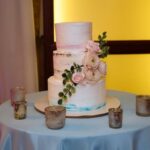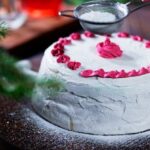Are you looking to elevate your cake decorating skills? Learn how to decorate your cake with royal icing, a versatile and traditional frosting that allows for intricate designs and vibrant colors. Royal icing is a popular choice for cake decorators due to its smooth finish and ability to hold intricate shapes and designs. Whether you’re a beginner or an experienced baker, incorporating royal icing into your decorating repertoire can take your cakes to the next level.
Royal icing is a sweet, hard-drying icing made from powdered sugar, egg whites or meringue powder, and water. Its smooth texture allows for precise detailing on cakes, making it ideal for creating elegant borders, intricate designs, and even hand-lettering. The versatility of royal icing makes it a favorite among bakers for decorating everything from wedding cakes to cookies.
One of the reasons why royal icing is favored by decorators is its ability to produce a glossy finish that adds a professional touch to any baked creation. Unlike buttercream or fondant, royal icing hardens when dried, creating a sturdy surface that can withstand stacking and transportation. Additionally, royal icing can be colored using gel food coloring or powdered food coloring, allowing for endless possibilities when it comes to creating unique designs on your cakes.
Essential Tools and Ingredients Needed for Decorating With Royal Icing
Royal icing is a versatile and popular choice for decorating cakes due to its smooth finish and ability to hold intricate designs. To achieve stunning results with royal icing, it’s important to have the right tools and ingredients on hand. Here are some essential items you’ll need to decorate your cake with royal icing:
Piping Bags and Tips
One of the key tools for working with royal icing is a piping bag fitted with various tips for different designs. From writing intricate details to creating borders and swirls, having a variety of piping tips will allow you to achieve different effects on your cake.
Offset Spatula
An offset spatula is essential for smoothing out royal icing on the surface of your cake. This tool helps create an even layer of icing and ensures a clean finish. It’s also handy for lifting delicate decorations without damaging them.
Gel Food Coloring
To achieve vibrant hues when coloring your royal icing, opt for gel food coloring instead of liquid food coloring. Gel colors are more concentrated, so you only need a small amount to create intense shades without altering the consistency of the icing.
Cake Turntable
A cake turntable is a helpful tool for decorating cakes with royal icing. It allows you to easily rotate the cake as you work, ensuring even coverage and smooth finishes on all sides. Invest in a sturdy turntable that can support the weight of your cakes for effortless decorating.
With these essential tools and ingredients in hand, you’ll be well-equipped to decorate your cakes with royal icing like a pro. Experiment with different techniques and designs to create stunning edible masterpieces that will impress your friends and family.
Preparing Your Cake for Royal Icing Decoration
Royal icing is a versatile and classic decorating technique that can add elegance and charm to any cake. Before you start creating intricate designs with royal icing, it is essential to prepare your cake properly to ensure a smooth canvas for your artistic creations. The key to a flawless finish lies in the preparation of the cake itself.
To ensure a smooth surface for decorating with royal icing, start by leveling your cake layers. Use a long serrated knife or a cake leveler to trim off any domed tops and create an even surface. This step is crucial as it provides a stable foundation for your decorations and prevents any unevenness in the final design.
Next, apply a crumb coat of frosting to the exterior of the cake. A crumb coat is a thin layer of frosting that seals in any loose crumbs and creates a smooth base for the final layer of royal icing. Once the crumb coat has set, you can proceed with applying the royal icing for your desired decorations.
Lastly, ensure that your cake is chilled before adding royal icing decorations. Chilling the cake helps the royal icing set faster and ensures that your designs stay in place once piped onto the surface. By following these simple tips and tricks for preparing your cake for royal icing decoration, you’ll be well on your way to creating stunning and professional-looking cakes.
| Tips & Tricks | Benefits |
|---|---|
| Leveling cake layers | Creates an even surface for decorating |
| Applying crumb coat | Seals in crumbs and provides smooth base |
| Chilling cake before decorating | Helps royal icing set faster |
How to Color Royal Icing
Royal icing is a versatile and popular choice for decorating cakes due to its smooth finish and beautiful designs. One of the key aspects of working with royal icing is learning how to color it effectively to achieve vibrant hues that will make your cake stand out. There are various techniques you can use to color royal icing, each with its own unique benefits and effects.
One common method for coloring royal icing is to use gel food coloring. Gel food coloring is highly concentrated, which means you only need a small amount to achieve intense colors. This type of coloring also helps maintain the consistency of the royal icing as liquid food coloring may dilute it too much. Simply add a small amount of gel coloring to your royal icing and mix well until you reach your desired shade.
Another technique for coloring royal icing is using powdered food colorings or luster dust. Powdered colors can create more muted tones and are perfect for achieving pastel hues or metallic finishes on your cake decorations. To use powdered colorings, simply mix them into your royal icing until fully incorporated. You may need to adjust the amount based on the intensity of color you want to achieve.
Lastly, you can also experiment with natural ingredients to color your royal icing, such as fruit powders or vegetable purees. These can add unique flavors and colors to your decorations while keeping them all-natural. Be mindful of the moisture content when using natural ingredients, as it can affect the consistency of the royal icing. By exploring different coloring techniques, you can add a personal touch and elevate the visual appeal of your decorated cakes with royal icing.
| Coloring Technique | Effect |
|---|---|
| Gel Food Coloring | Intense colors with maintained consistency |
| Powdered Food Coloring / Luster Dust | Muted tones, ideal for pastels or metallic finishes |
| Natural Ingredients (e.g. fruit powders) | All-natural colors with unique flavors |
Piping Techniques for Royal Icing Decoration
Piping techniques are essential for creating intricate and beautiful designs with royal icing on cakes. Whether you are looking to add borders, lines, or swirls to your cake decorations, mastering the art of piping can take your baked creations to the next level. With the right tools and a little practice, you can achieve professional-looking results that will impress your friends and family.
To start decorating your cakes with royal icing using piping techniques, you will need a piping bag fitted with a small round tip or a star tip depending on the design you want to create. Make sure to fill the piping bag with the desired color of royal icing and secure it tightly before beginning. It’s also helpful to have a practice surface where you can test out different designs before applying them to your cake.
When piping borders with royal icing, hold the piping bag at a slight angle above the cake surface and apply even pressure to create a smooth line. For lines and swirls, experiment with different pressures and movements to achieve varying thicknesses and shapes. Practice consistency is key when it comes to mastering piping techniques for royal icing decoration, so don’t be afraid to experiment and try new designs until you find what works best for you.
Advanced Royal Icing Techniques
Royal icing allows for a wide range of creative possibilities when it comes to cake decorating. While basic piping techniques are a great starting point, mastering advanced royal icing techniques can take your cakes to the next level. In this section, we will explore some tips and tricks for creating intricate designs and patterns using royal icing.
Using Stencils
One way to achieve intricate designs with royal icing is by using stencils. Stencils come in a variety of shapes and patterns, from simple geometric shapes to elaborate floral designs. To use a stencil with royal icing, simply place it on top of your cake and carefully spread the icing over the stencil using an offset spatula or palette knife. Once the icing is dry, gently remove the stencil to reveal the intricate design underneath.
Floodwork Technique
Another advanced technique for creating intricate designs with royal icing is known as floodwork. This technique involves outlining a design on your cake with a thicker consistency royal icing, then filling in the outlined area with a slightly thinner consistency icing. The thinner icing will flow smoothly into the outlined shape, creating a flat, seamless finish. Floodwork can be used to create detailed illustrations, lettering, or complex patterns on your cake.
Dimensional Designs
For cakes that truly stand out, consider incorporating dimensional designs using royal icing. By layering different colors and consistencies of royal icing on top of each other using piping bags fitted with various tips, you can create three-dimensional flowers, ruffles, or even sculpted figures on your cake. Practice patience and precision when building up these dimensional designs to ensure they hold their shape and add depth to your cake decoration.
By mastering these advanced royal icing techniques for creating intricate designs and patterns, you can elevate your cake decorating skills and impress friends and family with stunning edible works of art. Experiment with different tools, techniques, and color combinations to unleash your creativity and take your cakes to new heights of sophistication and elegance.
Using Royal Icing for Writing and Lettering on Cakes
Royal icing is not only a versatile medium for decorating cakes but also an excellent choice for writing and lettering on your baked creations. Whether you’re adding a personal message to a birthday cake or writing the name of the celebrant on a special occasion cake, royal icing provides a clean and professional look. Here are some tips and techniques on how to use royal icing for writing and lettering on cakes:
- Prepare your royal icing: Start by making a batch of stiff consistency royal icing using egg whites, confectioners’ sugar, and a touch of lemon juice or cream of tartar for stability. Make sure the icing is thick enough to hold its shape when piped.
- Use parchment paper cones or piping bags: Fill a parchment paper cone or piping bag fitted with a small round tip (such as Wilton #2 or #3) with the prepared royal icing. The smaller the tip size, the finer your writing will be.
- Practice your piping skills: Before piping directly onto your cake, practice writing letters and words on a flat surface such as parchment paper or a silicone mat. This will help you get comfortable with controlling the flow of the icing and achieving consistent letter shapes.
Once you feel confident with your piping skills, you can start writing on your cake with royal icing. Remember to apply gentle pressure to release the icing and move steadily to create smooth lines and elegant lettering.
When writing longer messages or intricate designs on cakes, it’s helpful to plan out your spacing and alignment beforehand. You can lightly mark guidelines on the cake’s surface using a toothpick before piping to ensure even spacing between letters and words.
With practice and patience, you can master the art of using royal icing for writing and lettering on cakes, adding a personalized touch to your dessert creations. Experiment with different fonts, sizes, and styles to make your cakes truly unique and memorable.
Troubleshooting Common Royal Icing Issues
Royal icing is a versatile and popular icing choice for decorating cakes and cookies. However, like any other decorating technique, there can be issues that arise when using royal icing. Common problems include cracking, air bubbles, and runny consistency. Here are some tips on how to troubleshoot these issues and achieve a flawless finish on your baked creations.
Cracking in royal icing can occur for various reasons, such as overmixing the icing or not adding enough liquid to the mixture. To prevent cracking, make sure to mix your royal icing just until it reaches stiff peaks and avoid overworking the icing. If cracking does occur, you can try adding a small amount of liquid to the icing and gently stirring it in until it becomes smooth again.
Air bubbles are another common issue when working with royal icing. These pesky bubbles can create uneven surfaces on your cake decorations. To avoid air bubbles, make sure to properly sift your powdered sugar before mixing it into the meringue powder and water.
Additionally, gently tapping the bowl of royal icing on the counter after mixing can help release any trapped air bubbles. If air bubbles still form, you can use a toothpick or skewer to carefully pop them before they dry.
Runny consistency is often a problem when decorating with royal icing, especially if you add too much liquid or underbeat the mixture. If your royal icing is too runny, try adding more powdered sugar gradually until you reach the desired consistency.
It’s essential to achieve the right balance of liquid and dry ingredients when working with royal icing to ensure that it holds its shape when piped onto your cakes or cookies. With these troubleshooting tips in mind, you’ll be able to tackle common issues with royal icing and create beautiful decorations for your baked goods effortlessly.
Tips for Storing Decorated Cakes With Royal Icing
Decorating a cake with royal icing is a labor of love that requires patience, skill, and attention to detail. Once you have put in the effort to create a stunning design on your cake, it is essential to know how to properly store and preserve your masterpiece. By following some simple tips and techniques, you can ensure that your beautifully decorated cake retains its beauty and flavor for as long as possible.
One important tip for storing decorated cakes with royal icing is to keep them in a cool, dry place away from direct sunlight. Excessive heat can cause the icing to melt or become sticky, compromising the design of your cake. Additionally, humidity can also affect the texture and appearance of royal icing, so it is best to store your decorated cake in a controlled environment.
Another key consideration when storing a decorated cake with royal icing is how to protect the design from smudging or getting damaged. One effective way to safeguard your creation is to carefully cover the cake with a clean cake dome or large container.
You can also use plastic wrap or wax paper to shield the icing from any potential contact or mishaps while in storage. By taking these precautions, you can help ensure that your hard work does not go to waste.
In conclusion, knowing how to properly store decorated cakes with royal icing is crucial in preserving the beauty and integrity of your creation. By following these tips for storing and protecting your masterpiece, you can enjoy the fruits of your labor for days after the decorating process. With proper care and attention, you can proudly display and savor your intricately designed cake for all to admire.
Frequently Asked Questions
Can I Use Royal Icing to Decorate a Cake?
Royal icing can be used to decorate a cake, but it is important to keep in mind that it dries very quickly once exposed to air. This makes it ideal for creating intricate designs and decorations on cakes due to its smooth texture.
How Long Does Royal Icing Last on a Cake?
The longevity of royal icing on a cake depends on the humidity levels in the environment. In a dry climate, royal icing can last for several days without any issues.
However, in a more humid environment, the icing may soften and lose its shape faster. It is best to consume a cake decorated with royal icing within a few days for the best quality.
Does Royal Icing Dry Hard?
Royal icing is known for drying hard, making it perfect for intricate decorations that need to hold their shape. Once the royal icing is applied to the cake and left to dry, it forms a firm and solid surface that can be touched or even stacked without getting damaged.
This characteristic makes royal icing popular for decorating cookies, gingerbread houses, and cakes where durability is needed.

Welcome to my blog about home and family. This blog is a place where I will share my thoughts, ideas, and experiences related to these important topics. I am a stay-at-home mom with two young children. I hope you enjoy reading it! and may find some helpful tips and ideas that will make your home and family life even better!





